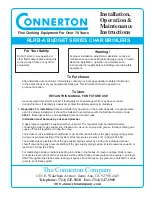
6.0 System Details
11
6.7
Sealed Systems
(Fig. 11)
1.
SAFETY VALVE
- A safety valve complying with
the requirements of BS 6750 Part 1 must be fitted
close to the boiler on the flow pipe by means of a
horizontal or vertically upward connection with no
intervening valve or restrictions and should be
positioned to facilitate testing. The valve should be
pre-set and non-adjustable to operate at a pressure
of 3 bar (45 Ibf/in
2
). It must be arranged to
discharge any water or steam through a pipe to a
safe outlet position.
2.
PRESSURE GAUGE
- A pressure gauge of
minimum range 0-4 bar (0-60 Ibf/in
2
) with a fill
pressure indicator must be fitted to the system,
preferably at the same point as the expansion
vessel in an easily visible position.
3.
EXPANSION VESSEL
- An expansion vessel
complying with the requirements of BS 4814 must
be fitted to the system by means of a connection
close to the inlet side of the circulating pump in
accordance with the manufacturers instructions, the
connecting pipe being unrestricted and not less
than 15mm (
1
/
2
in) nominal size. The volume of the
vessel should be suitable for the system water
content and the nitrogen or air charge pressure
should not be less than the system static head (See
Table. 1).
Further details of sealed system design can be
obtained from BS 5449 and the British Gas
publication entitled 'Specifications for Domestic Wet
Central Heating Systems'.
4.
FILLING POINT
- A filling point connection on
the central heating return pipework must be
provided to facilitate initial filling and pressurising
and also any subsequent water loss replacement /
refilling. The filling method adopted must be in
accordance with the Water Supply (Water Fittings)
regulations and the Water Bylaws (Scotland). Your
attention is drawn to: Paragraph 24 of Schedule 2
Section 8 of the publication Water Regulations
Guide which gives recommendations and guidance
on approved methods for filling sealed systems.
The sealed primary circuits may be filled or
replenished by means of a temporary connection
between the primary circuit and a supply pipe
provided the arrangement in accordance with
Diagram R24.2a of the Water Regulations Guide.
The temporary hose must be completely removed
at both ends after use.
5.
MAKE UP SYSTEM
- A method of replacing
water lost from the system should be provided
either by means of a make up vessel of not more
than 3 litres (5 pints) capacity, mounted above the
highest point of the system, or by re-pressurisation
of the system.
6.
VENTING
- A method of venting the system
during filling and commissioning must be provided
by fitting automatic air vents or by venting
manually.
7.
HOT WATER STORAGE
- The hot water
storage vessel must be of the indirect coil type. All
components used in the system must be suitable
for operation at 110°C (230°F) and at the pressure
allowed by the safety valve.
Safety
Valve
Pressure
Gauge
Pump
Filling
Point
Air
Vent
3 Litre
Top Up Bottle
(if required)
Radiator
Circuit
Expansion
Vessel
System Drains
at Low Point
Max Boiler Flow
Temp = 82° C
Boiler
Fig. 11
Table. 1
Vessel Charge
Pressure (Bar)
0.5
1.0
1.5
Initial System
Pressure (Bar)
0.5
1.0
1.5
2.0
1.0
1.5
2.0
1.5
2.0
Multiply Total
Water Content
Of System By
(Litres)
0.067
0.112
0.207
0.441
0.087
0.152
0.330
0.125
0.265
Method of determining minimum valve of
expansion vessel volume for sealed
systems using Baxi Boilers
System Volume = 75 litres
Vessel Charge Pressure = 1.0 bar
Initial System Pressure = 1.5 bar
75 x 0.152 = 11.4 litres
Expansion Vessel Volume
Example :-
Then :-
NOTE
Where a vessel of the calculated size is not obtainable
then the next available larger size should be used.
Stop
Valve
Double
Check
Valve
DHW
Mains
Inlet
CH
Return
Temporary
Hose
Stop
Valve
Fig. 11a
Содержание 100 He
Страница 45: ...16 0 Notes 45...
Страница 46: ...16 0 Notes 46...












































